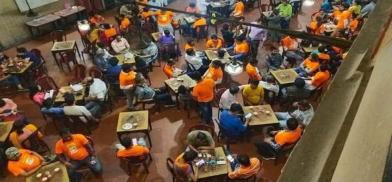Kolkata's storm in a coffee cup
The Indian Coffee House in Kolkata’s College Street has been a favourite haunt for the student community and intellectuals for ages

The Indian Coffee House in Kolkata’s College Street has been a favourite haunt for the student community and intellectuals for ages. So when political rivalry brews and tries to disturb the ambience in the stormy run-up to the assembly election, there is dismay too.
Eastern India has more takers for tea than coffee. With tea plantations spread over Assam and West Bengal’s Darjeeling area, it’s no wonder. However, lately urban areas, Kolkata in particular, have witnessed what is called a ‘cafe culture’, patronised by the young crowd who love to have their adda over steaming cups of coffee. Cafes have been popping up here and there almost every day, though some suffered during the lockdown in Covid time.
But Kolkata/Calcutta has had its iconic coffee house even from the 19th century on College Street, the intellectual hub with its university, colleges and book stores.
Though familiar to Kolkatans, the Indian Coffee House has suddenly come into national spotlight with rival parties in the fray for the West Bengal Assembly election making it a venue for ping-pong accusations. Posters for boycotting the ruling party at the Centre were pasted on its wall; then the party workers of the latter went for a coffee and on the way out, blackened the ‘No’ part of the ‘No Vote’ for them in the posters.
Then started another round of challenges from the opposite party. All this made some regular patrons protest that ‘their’ Coffee House be left alone from all the sloganeering.
But then, the Indian Coffee House, simply referred to as the Coffee House should become a vocal standoff point of rival parties on opposite spectrums should not be too much of a surprise. The place has always been a favourite adda zone for college students, intellectuals and artists and politics was never far behind.
Students and personalities who were to become famous later were regulars here, like filmmakers Satyajit Ray, Mrinal Sen, actor Soumitra Chatterjee, Aparna Sen, poet-author Sunil Gangopadhyay, poet Shakti Chattopadhyaya, Nobel Laureate Amartya Sen, to name a few.
It is said that during the tumultuous days of the 1960s- 70s when many young people, fed up with the socio-economic scenario of that time, wanted to bring in a change with radical leftist means were huddled in discussions on political ideology under the high ceiling of the Coffee House.
Many Little Magazines, an important independent voice in the Bengali publishing scene, were born from ideas thrashed around the simple no-frills atmosphere in the Coffee House with its wooden furniture.
Yet, the Coffee House started out quite innocuous as Albert Hall in 1876 on Bankim Chatterjee Street opposite the Presidency College (now university). The Indian Coffee House chain was started in 1936 by the Coffee Cess Committee.
Later, the Coffee Board decided to start a coffee joint from Albert Hall in 1942. However, in 1958, the management thought of shutting it down but it was re-opened the same year after professors of Presidency College and Calcutta University appealed through a special petition to the government to save the heritage place. It has since been run by a workers’ cooperative which broke away from the Coffee Board.
For a place so hallowed in memory and of heritage value, a newcomer is likely to miss the entrance squeezed between two bookstalls. But once you climb up the stairs the hum of raised voices will greet you beforehand to tell you that you have arrived at the right place. No one can accuse the Coffee House of hosting mute conversations!
It consists of two floors: the ground floor and the first floor. The first floor is a kind of verandah that overlooks the ground floor with corridors running across the four walls. Veterans joke (yes, regulars do not stop after student days, you will see many a grey heads) that they called the ground floor the ‘House of Commons', and the upper verandah the ‘House of Lords’.
Old timers talk about ‘Infusion’ coffee which used to cost two rupees less than milk coffee per cup. Students with hardly any pocket money even shared a cup sometimes. It must sound weird to the young today who do not mind spending Rs 150 a cup in some fancy café. Chicken Afghani was another signature dish but students could afford it only after saving some money. Sandwiches, mutton stew, some of the old items, still figure in the menu.
Coffee House in the boi para (book hub) is still popular with the young crowd, despite the so-called ‘with-it’ cafes, as it was in olden times. Manna Dey’s nostalgic paen -of love blooming and lost, friends moving on, in the song, Coffee House'er "shei adda’ta aaj aar nei" ( the Coffee house adda is not there any more), is still very popular and is aired on music channels regularly.
Recently, a new Coffee House opened in New Town, the tony neighbourhood on the way to the airport. The architecture replicates the College Street one, though materials for construction are not wood as in the old place.
The news of the launch galvanised people into making a beeline to the new address. In fact, in such great numbers that the management had to announce pre-booking as a must since social distance had also to be maintained and there was a constraint on number tables.
Who says Manna Dey’s iconic song is only about nostalgia? The love affair continues for the old Coffee House as it finds a new address while retaining its reputation as a favourite adda joint with the young and old alike in the old location (India Blooms)
Актуальные мероприятия всемирных подуимов.
Модные дома, торговые марки, высокая мода.
Приятное место для стильныех хайпбистов.
https://modastars.ru/








Post a Comment